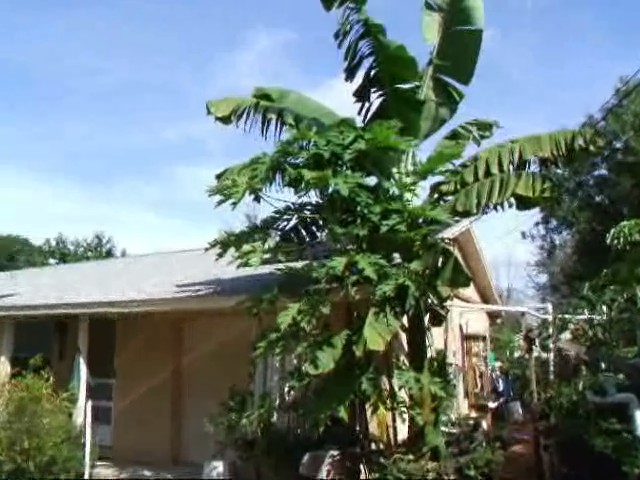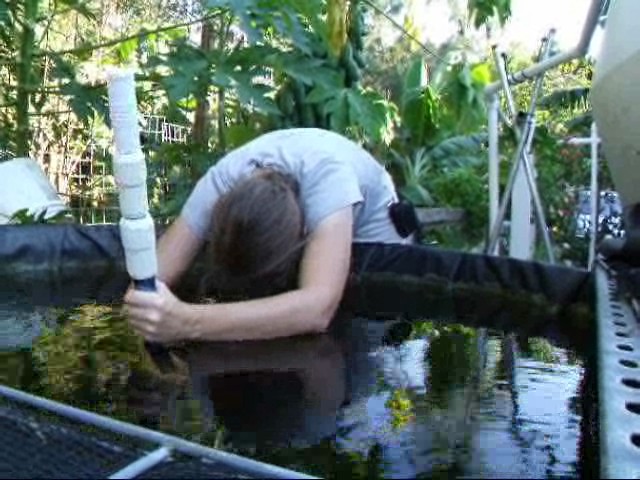Originally posted by TCLynx on AGC, June 9, 2010
Many people will ask “What’s with this Gravel Washing?” The answer is you don’t really want the random unknown sediment settling into your system and possibly damaging your pump or clogging up your grow beds and plumbing.
Now some media is fairly clean and some people get away with loading it into their grow beds and rinsing through with a hose and letting the water drain away outside the system. I don’t really advise this one for most gravels though as it only really washes the top layer of gravel leaving the rest of the sediment in the system.
There are choices about how to wash gravel. Some methods waste huge amounts of water while others don’t get the gravel very clean and still waste water. Other methods are very hard on the back.
My method has generally been to swish a plant basket full of gravel in a couple bins of water (successively cleaner water) and then dump into small buckets for transport to the grow beds. I usually set up my gravel washing station next to the pile of gravel and having lots of small buckets for transport is handy. I wash baskets of gravel and then dump them into the buckets in a garden cart, once the buckets are filled the garden cart can be moved over to the grow beds and buckets dumped into the grow beds. It is very important to set up your washing station at an appropriate height to avoid back strain. We used blocks and pallets to create a table for the bins of water so they would be at a comfortable height for the swishing of the gravel in the water. Baskets can be dropped on the pile and filled using a shovel so the only deep bending is to pick up the baskets. I find I’m better able to wash and move lots of gravel if I can stick with smaller bucket and basket fulls. If I start trying to lift and lug large buckets, I won’t keep at it very long and I’m far more likely to strain something. With the two or more rinse bin system, I find the first bin gets dirtiest and when it is just too dirty, we will dump that one and re-fill with the water from the cleaner bin and put fresh water in the final bin. If one needs to be really strict with water use. One could periodically let the bins settle and pour of the water from the top for re-use then scoop out the settled sediments and re-fill the bins with the water.
I’ve seen many novel ideas for gravel washing but for the most part, none of it seems worth the extra effort or water compared to the method I have used.
However, if one is in an arid area and the dust/dirt/sediment in the gravel has some clay. I would recommend some dry shaking before getting anything wet. Some method to shake or roll the dry gravel where the wind or gravity can carry the small loose dust away before getting to the rinsing stage. With sticky clay, it is best to get rid of what is loose before adding any water which would simply make it stick to the gravel even more.
Some types of gravel are going to require more washing than others. I’ve found red lava rock to need extra rinsing to avoid turning the whole system red for a very long time. The lava rock is also fragile so one needs to be careful during washing to avoid grinding more dust off of it in the process. At least it is light.
Even with washed gravel, when filling a brand new system, the water is likely to be cloudy at first. This will eventually clear and can sometimes be helped by using a sock or something to filter the water going back into the fish tank (it will need to be changed often though.) Now if you get part of a system up and cycled and then add more grow beds later, the water will clear quicker after adding the later grow beds as the existing beds already have a nice layer of bio-slime to collect the particles and hold them.
A few more notes. Some sediments or dust on some gravels can affect pH. If your gravel came from a place with lots of limestone dust or clay, washing well may assist in avoiding excessive buffering of the system during it’s start up. Other times gravel might have been sprayed or coated with something you don’t want in your system, let if you get gravel that was along the roadside for use in a highway project. If you notice an oil slick as you wash your gravel, you might want to think twice before putting it in the system.
Gravel washing is a special right of passage into the DIY aquaponics way of life, if you use gravel, don’t forgo the activity.
Kinda another topic but I will quickly here make not that you want to research your gravel a little bit before filling a system with it. Avoid gravels that will affect your pH too much. In particular limestone and marble will make the pH too high for most plants to do well. I would also advise against shells as media, though they can work, they will buffer the pH to 7.6 which is still a little too high for the plants (I know that one from personal experience, my main system has media that is about 40% shells, I manage but it could be so much better.)
Lava rock makes for great surface area but can be hard on the hands, smooth river rock will still work just fine, don’t get too wound up in it needing to have more surface area, as long as there is enough grow bed to support the load, it will work.





Leave a Reply